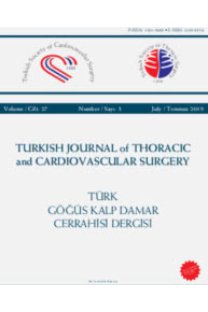Orta derece dilate çıkan aortun wrapping ile cerrahi tedavisi
Surgical treatment with wrapping of the moderately-dilated ascending aorta
___
- 23. Płonek T, Dumanski A, Nowicki R, Kustrzycki W. Computed tomography angiography of aorta subjected to external wrapping. J Cardiothorac Surg 2016;11:89.
- 22. Pecoraro F, Shingaki M, Steuer J, Chaykovska L, Rancic Z, Weber A, et al. Treatment of isolated ascending aortic aneurysm by off-pump epiaortic wrapping is safe and durable. Interact Cardiovasc Thorac Surg 2016;23:286-91.
- 21. Bauer M, Grauhan O, Hetzer R. Dislocated wrap after previous reduction aortoplasty causes erosion of the ascending aorta. Ann Thorac Surg 2003;75:583-4.
- 20. Neri E, Massetti M, Tanganelli P, Capannini G, Carone E, Tripodi A, et al. Is it only a mechanical matter? Histologic modifications of the aorta underlying external banding. J Thorac Cardiovasc Surg 1999;118:1116- 8.
- 19. Arsan S. How to avoid problems with reduction aortoplasty. Ann Thorac Surg 2004;78:386-7.
- 18. Dhillon JS, Randhawa GK, Straehley CJ, McNamara JJ. Late rupture after dacron wrapping of aortic aneurysms. Circulation 1986;74:11-4.
- 17. Akgun S, Atalan N, Fazlioğullari O, Kunt AT, Basaran C, Arsan S. Aortic root aneurysm after off-pump reduction aortoplasty. Ann Thorac Surg 2010;90:69-70.
- 16. Plonek T, Rylski B, Dumanski A, Siedlaczek P, Kustrzycki W. Biomechanical analysis of wrapping of the moderately dilated ascending aorta. J Cardiothorac Surg 2015;10:106.
- 15. Cohen O, Odim J, De la Zerda D, Ukatu C, Vyas R, Vyas N, et al. Long-term experience of girdling the ascending aorta with Dacron mesh as definitive treatment for aneurysmal dilation. Ann Thorac Surg 2007;83:780-4.
- 14. Gill M, Dunning J. Is reduction aortoplasty (with or without external wrap) an acceptable alternative to replacement of the dilated ascending aorta? Interact Cardiovasc Thorac Surg 2009;9:693-7.
- 13. Robicsek F, Cook JW, Reames MK Sr, Skipper ER. Size reduction ascending aortoplasty: is it dead or alive? J Thorac Cardiovasc Surg 2004;128:562-70.
- 12. Arsan S. Off-pump reduction aortoplasty and concomitant coronary artery bypass grafting. Ann Thorac Surg 2004;78:316-9.
- 11. Zhang H, Lu F, Qu D, Han L, Xu J, Ji G, et al. Treatment of fusiform ascending aortic aneurysms: a comparative study with 2 options. J Thorac Cardiovasc Surg 2011;141:738-43.
- 10. Belov IV, Stepanenko AB, Gens AP, Savichev DD, Charchyan ER. Reduction aortoplasty for ascending aortic aneurysm: a 14 -year experience. Asian Cardiovasc Thorac Ann 2009;17:162-6.
- 9. Lee SH, Kim JB, Kim DH, Jung SH, Choo SJ, Chung CH, et al. Management of dilated ascending aorta during aortic valve replacement: valve replacement alone versus aorta wrapping versus aorta replacement. J Thorac Cardiovasc Surg 2013;146:802-9.
- 8. Rylski B, Blanke P, Beyersdorf F, Desai ND, Milewski RK, Siepe M, et al. How does the ascending aorta geometry change when it dissects? J Am Coll Cardiol 2014;63:1311-9.
- 7. Erbel R, Aboyans V, Boileau C, Bossone E, Bartolomeo RD, Eggebrecht H, et al. 2014 ESC Guidelines on the diagnosis and treatment of aortic diseases: Document covering acute and chronic aortic diseases of the thoracic and abdominal aorta of the adult. The Task Force for the Diagnosis and Treatment of Aortic Diseases of the European Society of Cardiology (ESC). Eur Heart J 2014;35:2873-926.
- 6. Belov IV, Stepanenko AB, Gens AP, Savichev DD, Charchyan ER. Reduction aortoplasty for ascending aortic aneurysm: a 14 -year experience. Asian Cardiovasc Thorac Ann 2009;17:162-6.
- 5. Ergin MA, Spielvogel D, Apaydin A, Lansman SL, McCullough JN, Galla JD, et al. Surgical treatment of the dilated ascending aorta: when and how? Ann Thorac Surg 1999;67:1834-9.
- 4. Plonek T, Dumanski A, Nowicki R, Kustrzycki W. Single center experience with wrapping of the dilated ascending aorta. J Cardiothorac Surg 2015;10:168.
- 3. Thomeret G. Very successful cure of a true aneurysm of the abdominal aorta by wrapping with polythene cellophane. Mem Acad Chir (Paris) 1951;77:39-42.
- 2. Arsan S, Akgun S, Kurtoglu N, Yildirim T, Tekinsoy B. Reduction aortoplasty and external wrapping for moderately sized tubular ascending aortic aneurysm with concomitant operations. Ann Thorac Surg 2004;78:858 -61.
- 1. Plonek T. A meta analysis and systematic review of wrapping of the ascending aorta. J Card Surg 2014;29:809 -15.
- ISSN: 1301-5680
- Yayın Aralığı: 4
- Başlangıç: 1991
- Yayıncı: Bayçınar Tıbbi Yayıncılık
KABG hastalarını bilgilendirmek veya eğitmek
Hasan ERSÖZ, Aydın ŞANLI, Volkan KARAÇAM, İsmail AĞABABAOĞLU, Ali KARAKILIÇ, Fatma İlknur ULUGÜN
Çocuklarda düşük virülanslı kronik sternal osteomiyelit
Yüksel ATAY, Muhammet AKYÜZ, Engin KARAKUŞ, Onur IŞIK, Mehmet Fatih AYIK
Özkan ALATAŞ, Hidayet KAYANÇİÇEK, Ömer Faruk DOĞAN
Evren ÖZÇINAR, Mustafa Serkan DURDU, Mustafa Bahadır İNAN, Ahmet Rüçhan AKAR, Çağdaş BARAN, Sadık ERYILMAZ, Fatih GÜMÜŞ, Mehmet ÇAKICI
Rivaroksaban tedavisinin olumsuz bir etkisi olarak spontan hemotoraks
Hyang Rae LEE, Yi Yeong JEONG, Jong Deog LEE, Seung Jun LEE
İlginç bir mediastinal kist olgusu: Benign kistik mezotelyoma
Fazlı YANIK, Yekta Altemur KARAMUSTAFAOĞLU, Yener YÖRÜK, Fulya ÖZPUYAN
Atila EROĞLU, Ali Bilal ULAŞ, Yener AYDIN
Necip BECİT, Münacettin CEVİZ, Hikmet KOCAK, Uğur KAYA, Abdurrahim ÇOLAK
Periferik arter hastalıklarında endovasküler ve hibrid tedavi deneyimlerimiz
Ahmet Turan YILMAZ, Murat UĞUR, Veysel TEMİZKAN, Ejder KARDEŞOĞLU, Murat Fatih CAN, Alper UÇAK, İbrahim ALP, Arif SELÇUK
